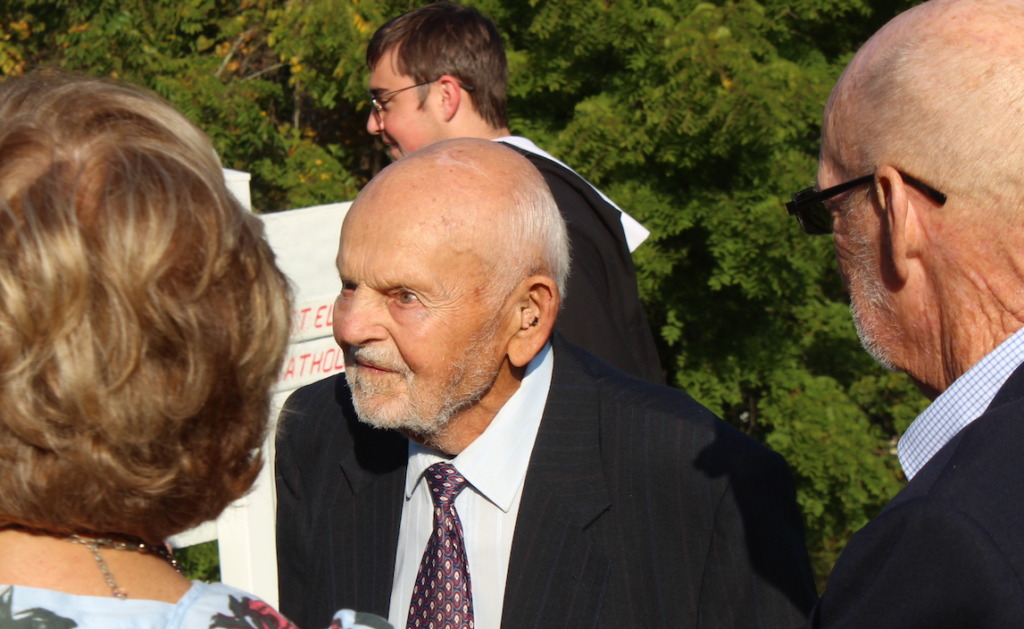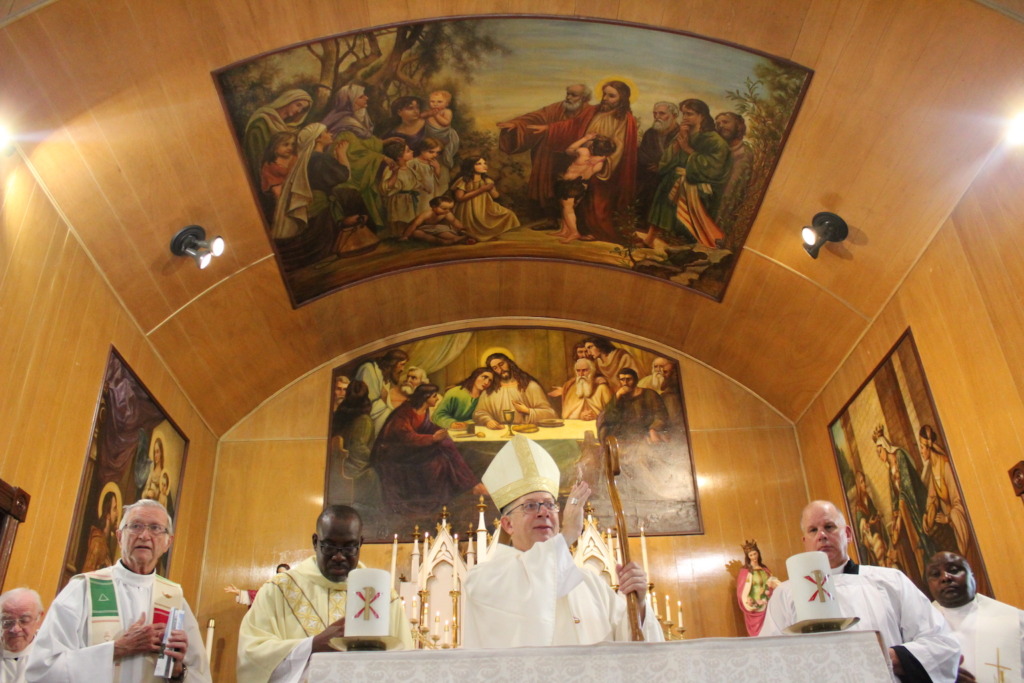Bishop celebrates Mass, blesses murals at St. Elizabeth, Pocahontas
The coal that built the community of Pocahontas in southwest Virginia and drew hundreds of immigrants to mine it is gone, but the seam of faith that led to the 125th anniversary of St. Elizabeth Church stretches on through another generation.
On the mild, sunny morning of Sunday, Sept. 18, parishioners from St. Elizabeth marked the life of a parish that has been around more than half as long as the entire country with Mass and the blessing of newly restored murals that adorn the sanctuary and ceiling. They were joined by Bishop Barry C. Knestout, diocesan personnel, former pastors and people from other Catholic parishes.
“What a beautiful gift that we rejoice in and give thanks for,” the bishop said in his homily to about 100 people in the polished, dark wood pews. He hoped that “all those who will purposefully ascend this little mountain or accidentally stumble upon this church and look at the beauty within it” may be “inspired by grace and by faith and will respond and live that faith and rejoice in God’s presence.”
“These were communities of mine workers, using their toil and strength to build this church,” said Father Eric Anokye, pastor of the Holy Family parish cluster to which St. Elizabeth belongs. “So, it has meant so much to them and it still means so much to the people who are still in this church.”
Drawn by the work in the mines owned by the Southwest Virginia Improvement Company, immigrants came to the region in the late 19th century with their families and their faith. Some were from Poland, Ireland and Italy, but most were from Hungary, whose beloved saint gave the parish its name.
In 1890, the company deeded land to the Diocese of Wheeling, West Virginia, and the white frame building that stands today was completed six years later. By 1974, St. Elizabeth, along with the rest of southwest Virginia, became part of the Diocese of Richmond.
As the mines continued to thrive in the early 20th century so did the parish. A rectory was built, and Benedictine priests served as pastors until the Great Depression. Some years they were performing 150 baptisms.
‘Most mature of communities’
In the ‘50s and ‘60s, the main challenge was the decline of the coal industry, many parishioners moving away to find new jobs. Still, the pastors remained steadfast in fostering a spirit of faith and community at St. Elizabeth.
“We’ve always had good shepherds here, very good priests. Thank God for that!” said 95-year-old Andrew Satmary, one of 14 children, all of whom were baptized at St. Elizabeth.
One of those 40 shepherds was Father Dan Brady, current pastor of St. Michael the Archangel, Glen Allen. He was pastor of St. Elizabeth and St. Theresa, Tazewell, from 1986-2006, adding the parishes in Grundy and Richlands in his last year.

“You can look at St. Elizabeth’s and say the parishioners are old,” he said. “But when I talk about the parish, I would tell people ‘We need to do this, this and this,’ and I could let it go because it’s the most mature of the communities. They took responsibility, and they would just do things, and we would work together, and it was just great. I learned a lot of how to be a pastor out here.”
Father Anthony Hoch, St. Elizabeth pastor from 1906-1932, was responsible for one of the church’s most significant features, the murals on the ceiling and in the sanctuary, painted by a friend, Theodore Brasch.
Depicting the Nativity, the Ascension, Christ with St. John and three other New Testament scenes, the 8 feet by 12 feet oils above the pews were restored by Judy Dotzel and Chris Norton of Trinity Artisans late last year and early this year. They returned for the blessing of the restored murals and brought up the offertory gifts during Mass.
They spent months removing years of grime and candle soot from those murals and four others in the sanctuary. A grant from the diocese financed the work, completed last spring, and diocesan archivist Edie Jeter said she’s been fielding lots of calls from people interested in seeing the murals.
In his homily, Bishop Knestout praised “these beautiful images that have been restored in a loving way.” Works showing the life of Christ, the bishop said, allow us “to place ourselves in the midst of those events and activities so that our lives and our hearts might be transformed.”
Deep roots
Satmary noted there wasn’t much St. Elizabeth parishioners couldn’t handle.
“Anything comes up, the parishioners have always been able to cope with it,” he said. “We’ve had ups and downs almost to the verge of one time we thought we were going to have to close down, but thank God we have been able to continue.”
Satmary was on the committee that planned the anniversary events, delayed a year by the pandemic. Other members were Father Anokye, Anne Danko, Barbara Jones, Jerry and Donna Lambert, and Vince and Sue Shumate.
Vince was baptized and received first Communion and confirmation in St. Elizabeth. As head of maintenance, he’s overseen repairs to the roof, electrical system and plumbing, and it was a proud day for him and his family.
“That we receive the support of the bishop and all the other churches makes everything work like we are one holy family,” he said.
The Dankos have been part of St. Elizabeth since the 1900s and had their own table at the reception after Mass. Paul Danko said his great-grandfather was one of those Hungarian immigrants who were “all very religious and thankful for what they had.”
Paul lives in Abingdon and, like his forebears, works in coal mining. Like all who attended the celebration, he was grateful to see Bishop Knestout.
“There’s just a few people that keep the church going, and it’s a challenge every year,” he said. “But having him come and participate was just a great thing.”
A parishioner for about 20 years, Joyce Shamro said she started going to St. Elizabeth after joining a prayer group. “Everyone else was just so accepting of me as a newcomer,” she said. “I find so many of those people are still alive, and it’s been really special to me to watch all their generations come.”
Parishioner Dale Ann Hawkins’ connection to the parish goes back generations.
“My grandparents were married there, my parents, all my aunts and uncles, some of my cousins,” she said. “There are many original families that are still in town, and in Pocahontas, the churches are the community.”

